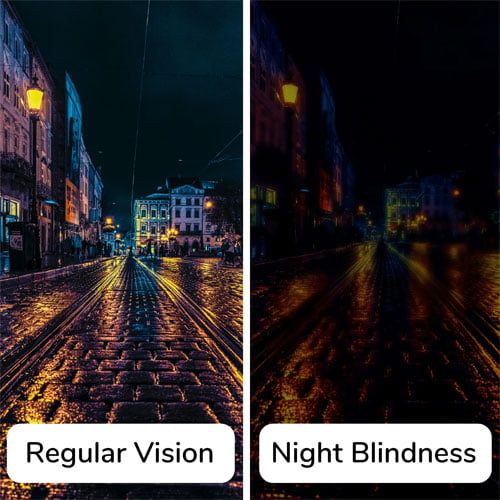Role of Pupil in Night Vision
Dilated pupils or abnormal constriction is one of the overlooked causes of impaired night vision. When pupils fail to respond properly to light, it can prevent light from focusing accurately on the macula — the center of sharp vision — resulting in blur, glare, or disorientation in low-light environments.

Comparison of normal vision and blurred vision caused by abnormal pupil dilation
The pupil is the gateway regulating light entering the eye. At night or in darkness, the pupil expands to gather more light, supporting retinal function. If the pupil becomes unresponsive — overly dilated, constricted, or uneven — light fails to be regulated, causing blur or glare.
This pupil dilation mechanism is physiological. However, when the dilation/constriction is abnormal, light cannot focus on the macula properly — causing distortion or glare, which contributes to macular misalignment.
📌 This condition is often mistaken for mild myopia or eye fatigue, though it may indicate optic nerve issues.
When is Pupil Behavior Considered Abnormal?

Neural mechanism controlling pupil dilation and constriction in response to light.
| Disorder Type | Description |
|---|---|
| Mydriasis | Excessive pupil dilation, common with medication or nerve injury |
| Miosis | Excessive pupil constriction, limiting light entry into the retina |
| Anisocoria | Unequal pupil sizes — may signal brain or optic nerve damage |
📌 These disorders may stem from neurodegeneration, head trauma, or ocular diseases involving the cornea or lens.
Early Warning Signs
- Blurred vision in dim environments
- Halos or streaks around headlights
- Eye strain or poor focus during night driving
- Visual “flares” or distortion under artificial lights
💡 These symptoms are often confused with digital eye strain.
Common Causes
- Pupil-dilating drops, antidepressants, or hypertension meds
- Glaucoma or oculomotor nerve damage
- Corneal surgery, cataracts, or post-op complications
- Focus fatigue from prolonged near work or uncorrected astigmatism
👉 If you notice unexplained vision changes, don’t rule out underlying refractive errors such as mild astigmatism or hidden farsightedness.
Impact on Night Life

Blurred night driving vision due to abnormal pupil response
Abnormal pupil function severely affects low-light vision. People may feel less confident driving, face higher accident risks, or struggle with night activities. It also burdens the already-aging focusing system — especially after 40 when presbyopia starts.
Diagnosis and Treatment
- Pupil size and light reflex testing
- Fundoscopy and OCT scans to assess optic nerve health
- Intraocular pressure check to rule out glaucoma
Treatment depends on the root cause:
- Discontinue or change current medications
- Medical treatment for neurological or glaucoma-related causes
- Consider refractive surgery if caused by visual disorders
Expert Advice
- Don’t ignore nighttime blur even if daytime vision seems fine
- Avoid unsupervised use of pupil-dilating eye drops
- Use anti-glare glasses when driving at night
- Get eye exams every 6 months, especially if on neurological meds
Conclusion
Abnormal pupil dilation or constriction might be temporary, but it could also indicate deeper optic nerve issues. Accurate diagnosis and appropriate treatment can improve night vision and prevent long-term complications.

 vi
vi 22-Jun-2025
22-Jun-2025










 0916.741.763
0916.741.763 Appointment
Appointment